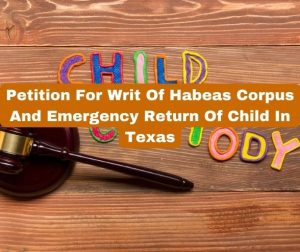When a child is wrongfully taken or withheld from their legal guardian, the situation can quickly escalate into a complex legal battle. In Texas, one critical tool available to guardians in such cases is the petition for a Writ of Habeas Corpus, which can also include an emergency return of the child. This legal action demands that a person who has your child must appear in court with the child and justify their actions. Understanding the nuances of this petition can be pivotal in swiftly addressing custody disputes and ensuring the child’s welfare. In this blog post, we’ll delve into what a Writ of Habeas Corpus entails, the specifics of filing such a petition in Texas, and how to navigate the legal landscape to protect your rights and the well-being of your child.
Contents
Understanding Writ Of Habeas Corpus In Child Custody Cases
The term “Writ of Habeas Corpus” is a Latin phrase that literally means “you shall have the body.” In the context of child custody, it is a directive issued by the court requiring the person who has the child to appear in court with the child and explain why they should retain custody. This legal tool is crucial when a child has been unlawfully taken or is wrongfully retained by someone other than the legal guardian.
In Texas, such a writ can be utilized in scenarios where a non-custodial parent refuses to return the child to the custodial parent, or when a child is taken by a relative without parental consent. It’s important to recognize that this petition is not limited to parents alone but can also be used by guardians or others with legal custody rights under specific circumstances.
To initiate this process, one must first establish that they have a legitimate right to custody and that there has been a clear violation of this right. This requires gathering all pertinent custody agreements, court orders, or any other relevant legal documentation that substantiates your custodial claim. Starting this process involves understanding not only your rights but also the precise legal obligations and limitations that apply to your case.
Legal Requirements For Filing A Petition In Texas
Filing a petition for a Writ of Habeas Corpus in Texas begins with ensuring you meet all legal prerequisites and gather the necessary documentation. This includes the most current custody orders, any relevant legal agreements, and evidence that the child’s current living situation violates these orders. It’s also critical to verify that you file your petition in the correct jurisdiction, typically where the child currently resides or where the original custody order was issued.
Documentation plays a crucial role in these proceedings. Essential paperwork often includes the child’s birth certificate, identification of the child and the guardian, and a detailed account of the events leading up to the unlawful custody situation. This meticulous preparation is indispensable because it forms the basis of your legal argument and influences the court’s initial perception of your case.
Once you have prepared your documentation, the next step is to file the petition with the appropriate court. This filing sets the legal process in motion and will result in a court hearing where both parties can present their arguments. It’s imperative to prepare thoroughly for this hearing, understanding that the court’s primary concern is the welfare of the child. This preparation includes organizing your evidence, planning your legal arguments, and possibly, arranging for legal representation to ensure that your case is presented as effectively as possible.
The Process Of Filing For Emergency Return Of A Child
 The process of filing a petition for an emergency return of a child involves several critical steps that must be followed diligently to ensure the effectiveness of your legal actions. Once you have your documents and legal basis prepared, as previously discussed, the actual filing marks the beginning of a formal legal process aimed at returning your child safely and quickly.
The process of filing a petition for an emergency return of a child involves several critical steps that must be followed diligently to ensure the effectiveness of your legal actions. Once you have your documents and legal basis prepared, as previously discussed, the actual filing marks the beginning of a formal legal process aimed at returning your child safely and quickly.
The first step in this process is the actual submission of the petition to the court. This submission must include all the collected evidence, the legal paperwork substantiating your custodial rights, and a detailed affidavit explaining the urgency of the child’s return. The affidavit should clearly outline the circumstances that led to the need for an emergency petition, such as the unlawful detention of the child or a direct threat to the child’s well-being.
Following the filing, the court will typically expedite the proceedings given the emergency nature of the situation. A hearing date is often set quickly, and the respondent — the person from whom the child’s return is sought — is served with a notice to appear in court with the child. It’s crucial to understand the timeline of these events, as they can vary based on the court’s schedule and the specific details of the case. Preparing for this hearing involves not only reviewing the facts of the case and the legal arguments but also anticipating the possible defenses the respondent might use.
During the hearing, both parties will have the opportunity to present their cases. This is where your preparation will be tested, as you must convincingly argue that the child’s current situation violates your legal custodial rights and that their immediate return is in their best interest. This involves not only presenting your case clearly and effectively but also responding to any counterarguments presented by the opposing party. The judge will then make a decision based on the evidence and arguments provided, focusing on what best serves the child’s immediate and long-term welfare.
If the petition is granted, the court will issue an order for the child’s return. However, it’s important to be prepared for any outcome. If the decision is not in your favor, understanding your options for appeal or re-filing can be crucial. In all cases, the focus must remain on the child’s safety and well-being, guiding all legal strategies and actions.
Legal Outcomes And Potential Scenarios
Navigating through the legal outcomes and understanding the potential scenarios that can arise from filing a Writ of Habeas Corpus for the emergency return of a child is essential for any guardian or parent involved in such a distressing situation. Each case can result in different outcomes, depending on the specifics of the situation and how well the legal arguments are presented in court.
When a petition for a Writ of Habeas Corpus is granted, it typically results in the immediate return of the child to the petitioner, under the presumption that the child was wrongfully held by the respondent. This outcome is seen as a vindication of the petitioner’s custodial rights and a reinforcement of legal custody arrangements. It is a direct and clear decision that aims to rectify any wrongful detention of the child.
However, if the court denies the petition, the reasons can vary widely. The court might find that the petitioner does not have a clear legal right to custody, or perhaps the respondent has demonstrated a valid legal reason for retaining the child—such as concerns over the child’s safety or well-being if returned to the petitioner. In these cases, understanding why the petition was denied is crucial for determining the next steps, which may include seeking modifications to custody arrangements or addressing specific issues cited by the court.
For those facing the challenge of a denied petition, the path forward can involve re-evaluating the legal strategy, possibly gathering more evidence, or addressing legal deficiencies in the initial petition. Consulting with a legal expert to better understand the nuances of the ruling and to formulate a robust appeal or a new legal approach is often necessary.
Regardless of the outcome, it is vital for all parties involved to focus on what best serves the interests and welfare of the child. This often requires ongoing legal consultation and possibly engaging in mediation or other dispute resolution methods to ensure that any further legal actions are well-informed and carefully considered. Understanding these potential scenarios and preparing for them from the start can greatly influence the effectiveness of your legal actions and the well-being of your child.
Petition For Writ Of Habeas Corpus FAQ
What Is A Writ Of Habeas Corpus Return Of Child In Texas?
What Are The Grounds For A Writ Of Habeas Corpus In Texas?
Why Would Someone File A Writ Of Habeas Corpus And Emergency Return Of Child In Texas?

Attorney Daryl Longworth is a family law attorney licensed by the State Bar of Texas. He is the senior attorney at The Longworth Law Firm in Houston, Texas. Mr. Longworth is a graduate of the University of Houston Law Center. Prior to becoming a licensed attorney focusing on divorce law and family law in Texas, Mr. Longworth was a police officer for the Houston Police Department.
